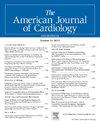Comparison of Anatomical and Physiological Indices of Angiographically Intermediate Left Main Coronary Artery Stenoses
IF 2.1
3区 医学
Q2 CARDIAC & CARDIOVASCULAR SYSTEMS
引用次数: 0
Abstract
Although physiologic evaluation (e.g., fractional flow reserve) of intermediate lesions is well established in other coronary arteries, the left main coronary artery (LMCA) exhibits diagnostic challenges, hindering development of physiology-based decision-making algorithms. The aim of this study is to evaluate the relationship between angiographic stenosis severity (diameter stenosis, DS%), lesion location and morphologic characteristics and gold-standard pressure indices in patients with intermediate LMCA stenosis. We analyzed 34 patients with angiographically intermediate (25%–65%) LMCA stenosis who underwent intravascular ultrasound (IVUS) imaging and pressure wire assessment. Plaque burden, minimal lumen area (MLA), lesion location, and calcification were documented, and their relationships with FFR and iFR were evaluated. The iFR (r = -0.507 p < 0.001) and FFR (r = -0.383 p = 0.002) were only moderately correlated with DS%. FFR (r = 0.835, p < 0.001) and iFR (r = 0.769, p < 0.001) were significantly correlated with MLA. Presence of calcification partially blunted the correlation between structural and functional parameters. The receiver operating characteristic (ROC) curve showed the highest area under the curve (AUC) for FFR in detecting an MLA<6 mm², with a negative predictive value (NPV) of 80% and a positive predictive value (PPV) of 100%. All lesions with an MLA<6mm2 (n = 16) had an FFR <0.80 whereas iFR >0.89 deferred 37% of these lesions. In conclusion, angiographic percent stenosis is an unreliable indicator of hemodynamic significance in intermediate LMCA disease; given that iFR has a high false-negative rate for lesions with MLA <6 mm² despite correlating with MLA, FFR may therefore be a more suitable index for evaluating intermediate LMCA stenoses, and further studies should refine cutoffs for nonhyperemic indices and investigate their clinical implications.
冠状动脉左主干中度狭窄的造影解剖与生理指标比较。
尽管在其他冠状动脉中对中间病变的生理评估(例如,分数血流储备)已经很好地建立起来,但左冠状动脉主干(LMCA)表现出诊断挑战,阻碍了基于生理的决策算法的发展。本研究的目的是评估中度LMCA狭窄患者血管造影狭窄严重程度(狭窄直径,DS%)、病变位置和形态学特征与金标准压力指数之间的关系。我们分析了34例血管造影中度(25-65%)LMCA狭窄的患者,他们接受了血管内超声(IVUS)成像和压力丝评估。记录斑块负担、最小管腔面积(MLA)、病变位置和钙化情况,并评估它们与FFR和iFR的关系。iFR (r=-0.507 p2 (n=16))的FFR为0.89,延迟了37%的病变。综上所述,血管造影狭窄百分比是衡量中度LMCA疾病血流动力学意义的不可靠指标;鉴于iFR对MLA病变的假阴性率很高
本文章由计算机程序翻译,如有差异,请以英文原文为准。
求助全文
约1分钟内获得全文
求助全文
来源期刊

American Journal of Cardiology
医学-心血管系统
CiteScore
4.00
自引率
3.60%
发文量
698
审稿时长
33 days
期刊介绍:
Published 24 times a year, The American Journal of Cardiology® is an independent journal designed for cardiovascular disease specialists and internists with a subspecialty in cardiology throughout the world. AJC is an independent, scientific, peer-reviewed journal of original articles that focus on the practical, clinical approach to the diagnosis and treatment of cardiovascular disease. AJC has one of the fastest acceptance to publication times in Cardiology. Features report on systemic hypertension, methodology, drugs, pacing, arrhythmia, preventive cardiology, congestive heart failure, valvular heart disease, congenital heart disease, and cardiomyopathy. Also included are editorials, readers'' comments, and symposia.
 求助内容:
求助内容: 应助结果提醒方式:
应助结果提醒方式:


